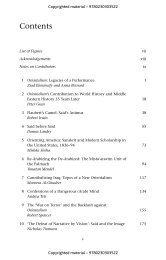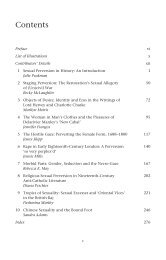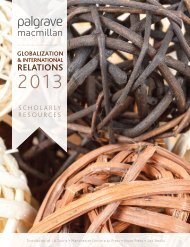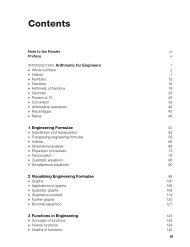Download sample chapter - Palgrave
Download sample chapter - Palgrave
Download sample chapter - Palgrave
You also want an ePaper? Increase the reach of your titles
YUMPU automatically turns print PDFs into web optimized ePapers that Google loves.
Copyrighted material – 9781137343512<br />
8 / florence vatan and marc silberman<br />
Ofelia Ferrán’s <strong>chapter</strong> “Grievability and the Politics of Visibility: The<br />
Photography of Francesc Torres and the Mass Graves of the Spanish Civil<br />
War” focuses on two photographic memory projects by multimedia artist<br />
Francesc Torres: the 2007 photography exhibit and its accompanying catalogue,<br />
Oscura es la habitación donde dormimos (Dark Is the Room Where We<br />
Sleep). These projects document the 2004 exhumation in Villamayor de<br />
los Montes of a mass grave containing the bodies of 46 Republicans. After<br />
years of silence about Francoist repression the grassroots “movement for<br />
the recuperation of historical memory” has started to confront the legacy<br />
of the Civil War and dictatorship in Spain, leading to the exhumation of<br />
mass graves throughout the country. Torres’s photographic project commemorates<br />
the victims, acknowledging their right for a proper burial and<br />
the value of their life and ideals. The project invites viewers to engage<br />
with the victims. As such, it performs what Ariella Azoulay calls the “civil<br />
contract of photography.” 10 This intergenerational transfer initiates a sense<br />
of community and civic responsibility committed to keeping alive the victims’<br />
heritage and to live up to the values they embody.<br />
Robyn Autry’s <strong>chapter</strong> on “Doing Memory in Public: Postapartheid<br />
Memorial Space as an Activist Project” explores how two South African<br />
memorial projects—Freedom Park, a state-directed national heritage project<br />
in Pretoria, and the District Six Museum, a community-based effort in<br />
Cape Town—give voice to dissident histories and memories silenced during<br />
apartheid. The <strong>chapter</strong> also examines the difficulties and contradictions<br />
involved in the attempts to accommodate conflicting memories in a society<br />
still deeply divided. A counter monument to the infamous apartheid-era<br />
Voortrekker Monument, Freedom Park with its postcolonial, Afrocentric<br />
monumentality reworks the understanding of South African national identity.<br />
Yet its own shortcomings elicited criticism and led to counter initiatives.<br />
In a different context the District Six Museum collected people’s<br />
stories and memorabilia in order to create a “memory culture from below”<br />
and to reclaim a neighborhood from which Coloured people had been<br />
expelled decades earlier. Yet the project was fraught with ambivalence and<br />
tensions in its effort to avoid racial language and imagery, in its strategies<br />
to reclaim the District Six physical space, and in its increased attention to<br />
the appeal of South Africa’s international tourist industry. Expanding the<br />
transcultural and transcontinental angle, Laurie Beth Clark’s contribution<br />
on “Mnemonic Objects: Forensic and Rhetorical Practices in Memorial<br />
Culture” considers how objects are staged as mnemonic devices and how<br />
they operate in heterogeneous and contested ways. With examples from<br />
Europe, Africa, Asia, North and South America, she considers the tension<br />
between a forensic impulse that uses objects as proof of crimes and a<br />
semiotic function in which objects stand in metonymically for the dead or<br />
Copyrighted material – 9781137343512
















